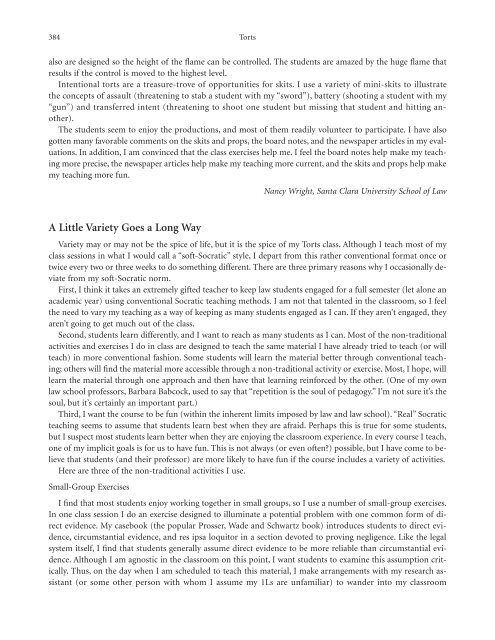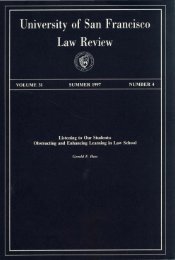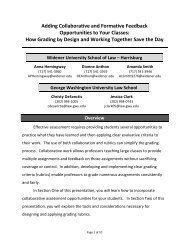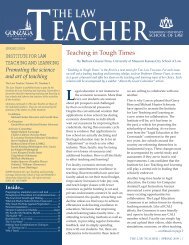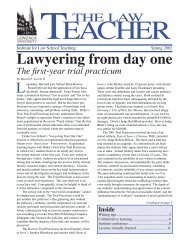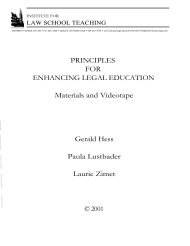Teaching the Law School Curriculum - Institute for Law Teaching ...
Teaching the Law School Curriculum - Institute for Law Teaching ...
Teaching the Law School Curriculum - Institute for Law Teaching ...
Create successful ePaper yourself
Turn your PDF publications into a flip-book with our unique Google optimized e-Paper software.
384 Torts<br />
also are designed so <strong>the</strong> height of <strong>the</strong> flame can be controlled. The students are amazed by <strong>the</strong> huge flame that<br />
results if <strong>the</strong> control is moved to <strong>the</strong> highest level.<br />
Intentional torts are a treasure-trove of opportunities <strong>for</strong> skits. I use a variety of mini-skits to illustrate<br />
<strong>the</strong> concepts of assault (threatening to stab a student with my “sword”), battery (shooting a student with my<br />
“gun”) and transferred intent (threatening to shoot one student but missing that student and hitting ano<strong>the</strong>r).<br />
The students seem to enjoy <strong>the</strong> productions, and most of <strong>the</strong>m readily volunteer to participate. I have also<br />
gotten many favorable comments on <strong>the</strong> skits and props, <strong>the</strong> board notes, and <strong>the</strong> newspaper articles in my evaluations.<br />
In addition, I am convinced that <strong>the</strong> class exercises help me. I feel <strong>the</strong> board notes help make my teaching<br />
more precise, <strong>the</strong> newspaper articles help make my teaching more current, and <strong>the</strong> skits and props help make<br />
my teaching more fun.<br />
A Little Variety Goes a Long Way<br />
Nancy Wright, Santa Clara University <strong>School</strong> of <strong>Law</strong><br />
Variety may or may not be <strong>the</strong> spice of life, but it is <strong>the</strong> spice of my Torts class. Although I teach most of my<br />
class sessions in what I would call a “soft-Socratic” style, I depart from this ra<strong>the</strong>r conventional <strong>for</strong>mat once or<br />
twice every two or three weeks to do something different. There are three primary reasons why I occasionally deviate<br />
from my soft-Socratic norm.<br />
First, I think it takes an extremely gifted teacher to keep law students engaged <strong>for</strong> a full semester (let alone an<br />
academic year) using conventional Socratic teaching methods. I am not that talented in <strong>the</strong> classroom, so I feel<br />
<strong>the</strong> need to vary my teaching as a way of keeping as many students engaged as I can. If <strong>the</strong>y aren’t engaged, <strong>the</strong>y<br />
aren’t going to get much out of <strong>the</strong> class.<br />
Second, students learn differently, and I want to reach as many students as I can. Most of <strong>the</strong> non-traditional<br />
activities and exercises I do in class are designed to teach <strong>the</strong> same material I have already tried to teach (or will<br />
teach) in more conventional fashion. Some students will learn <strong>the</strong> material better through conventional teaching;<br />
o<strong>the</strong>rs will find <strong>the</strong> material more accessible through a non-traditional activity or exercise. Most, I hope, will<br />
learn <strong>the</strong> material through one approach and <strong>the</strong>n have that learning rein<strong>for</strong>ced by <strong>the</strong> o<strong>the</strong>r. (One of my own<br />
law school professors, Barbara Babcock, used to say that “repetition is <strong>the</strong> soul of pedagogy.” I’m not sure it’s <strong>the</strong><br />
soul, but it’s certainly an important part.)<br />
Third, I want <strong>the</strong> course to be fun (within <strong>the</strong> inherent limits imposed by law and law school). “Real” Socratic<br />
teaching seems to assume that students learn best when <strong>the</strong>y are afraid. Perhaps this is true <strong>for</strong> some students,<br />
but I suspect most students learn better when <strong>the</strong>y are enjoying <strong>the</strong> classroom experience. In every course I teach,<br />
one of my implicit goals is <strong>for</strong> us to have fun. This is not always (or even often?) possible, but I have come to believe<br />
that students (and <strong>the</strong>ir professor) are more likely to have fun if <strong>the</strong> course includes a variety of activities.<br />
Here are three of <strong>the</strong> non-traditional activities I use.<br />
Small-Group Exercises<br />
I find that most students enjoy working toge<strong>the</strong>r in small groups, so I use a number of small-group exercises.<br />
In one class session I do an exercise designed to illuminate a potential problem with one common <strong>for</strong>m of direct<br />
evidence. My casebook (<strong>the</strong> popular Prosser, Wade and Schwartz book) introduces students to direct evidence,<br />
circumstantial evidence, and res ipsa loquitor in a section devoted to proving negligence. Like <strong>the</strong> legal<br />
system itself, I find that students generally assume direct evidence to be more reliable than circumstantial evidence.<br />
Although I am agnostic in <strong>the</strong> classroom on this point, I want students to examine this assumption critically.<br />
Thus, on <strong>the</strong> day when I am scheduled to teach this material, I make arrangements with my research assistant<br />
(or some o<strong>the</strong>r person with whom I assume my 1Ls are unfamiliar) to wander into my classroom


